Today, we meet Salty McGuire, the gob! You’ll always find him on the job…
Truthfully, I’ve exhausted most of my knowledge on the historical background of Terrytoons, having written about the studio and its artists extensively during the last Terry breakdown, so this write-up will not be as dense. (The next breakdown I have planned will be more in-depth, so be on the lookout!)
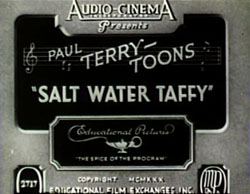 Salt Water Taffy (released November 30th, 1930) is an ambitious early sound Terrytoon, evident in Salty’s song sequences, which show an inventive use of lip-sync for its time, primarily by head animator Frank Moser. Though a standard entry, it has some nice things to highlight. The timing in scenes 5A-5C, when the anchor is dropped onto the swimming monkey’s head, is nicely done. Scene 13A – animated by Ferdinand Horvath – is handled nicely, thanks to Phil Scheib’s music, when the hippo is raised by the derrick hook (the payoff writes itself).
Salt Water Taffy (released November 30th, 1930) is an ambitious early sound Terrytoon, evident in Salty’s song sequences, which show an inventive use of lip-sync for its time, primarily by head animator Frank Moser. Though a standard entry, it has some nice things to highlight. The timing in scenes 5A-5C, when the anchor is dropped onto the swimming monkey’s head, is nicely done. Scene 13A – animated by Ferdinand Horvath – is handled nicely, thanks to Phil Scheib’s music, when the hippo is raised by the derrick hook (the payoff writes itself).
Producer Paul Terry is credited for two shots, when a mosquito interacts with another drunken member of his ilk. There is also a light semblance of personality humor within that sequence. The insect, gratuitously sharpening its long proboscis with a pencil sharpener and razor strap, could serve as a playful send-up of Winsor McCay’s How A Mosquito Operates. Another nice touch of the sequence’s aura is the elephant’s discomfited take to the camera before he turns his back to button his pants. Scene 25 of Art Babbitt’s octopus and shark is one of the strangest moments in the early sound Terrytoons. There is also some striking movement in scene 32’s dour moment of the shark sinking to his death.
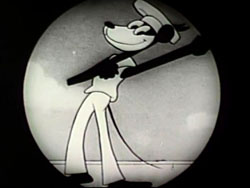 In the draft for this cartoon, you may notice many scenes where Frank Moser shares credit with other artists, such as Larry Silverman, Art Babbitt, Ferdinand Horvath and “Sarka.” The credits below an animator’s name were designated for the assistant animators. The assistants cleaned up the in-betweens, while Moser did the same for his key drawings.
In the draft for this cartoon, you may notice many scenes where Frank Moser shares credit with other artists, such as Larry Silverman, Art Babbitt, Ferdinand Horvath and “Sarka.” The credits below an animator’s name were designated for the assistant animators. The assistants cleaned up the in-betweens, while Moser did the same for his key drawings.
There is no contemporaneous evidence if “Sarka” is, in fact, fine artist Charles Sarka. If he worked for Terrytoons, his stay would not have lasted long. Just in case, I’d like to provide some background. Born in Chicago in 1879, Sarka apprenticed as an engraver at age 11. He eventually became a staff artist for the Chicago Record and moved to the New York Herald. An extensive traveler, he explored such exotic locales such as Egypt, the South Pacific and North Africa, which influenced the Oriental nature of his various watercolors. By 1908, Sarka re-located to New York where he became a magazine illustrator for Blue Book, Collier’s and Harper’s. He had sold very little of his painting during the Depression but contributed to mural commissions under the New Deal. During WWII, he illustrated posters for the WPA. He continued painting up until his seventies before he passed in 1960.
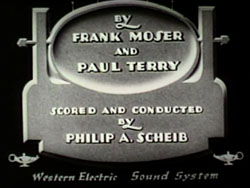 Salt Water Taffy is one the earliest Terrytoons in circulation to have its original titles, not stricken by the Barker Bill television alterations from the ‘50s. The draft credits Art Babbitt for its titles, indicative that he illustrated characters on them, much in the fashion as the Hungarian Ghoulash title displayed. The 35mm British prints for the 1931 Terrytoons Club Sandwich and Popcorn have special illustrations on the titles, but this cartoon – and the previously analyzed Lorelei — curiously does not.
Salt Water Taffy is one the earliest Terrytoons in circulation to have its original titles, not stricken by the Barker Bill television alterations from the ‘50s. The draft credits Art Babbitt for its titles, indicative that he illustrated characters on them, much in the fashion as the Hungarian Ghoulash title displayed. The 35mm British prints for the 1931 Terrytoons Club Sandwich and Popcorn have special illustrations on the titles, but this cartoon – and the previously analyzed Lorelei — curiously does not.
Enjoy this week’s breakdown, ya swabs!

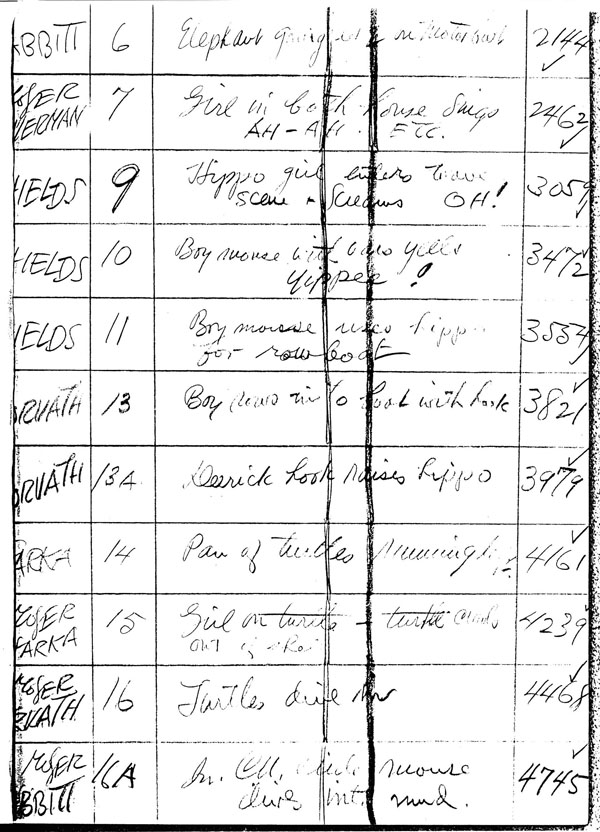
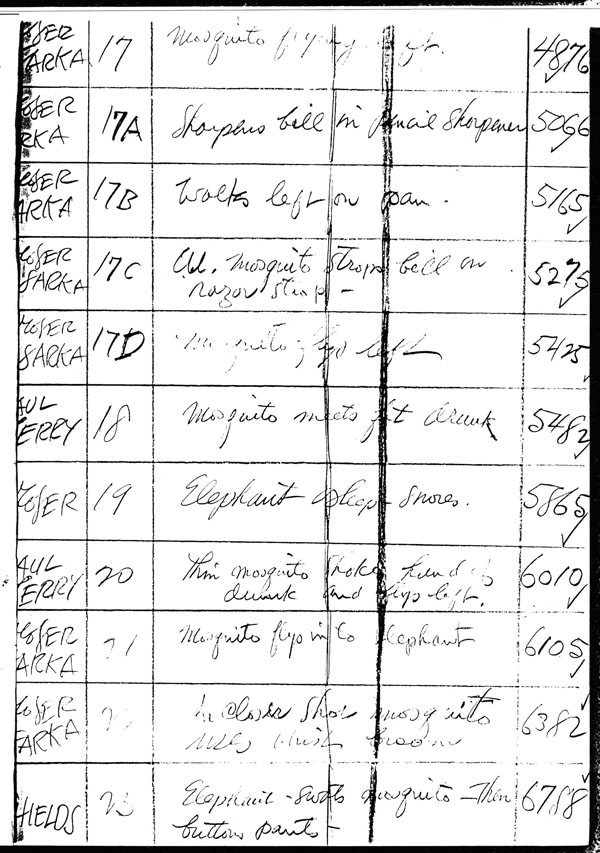
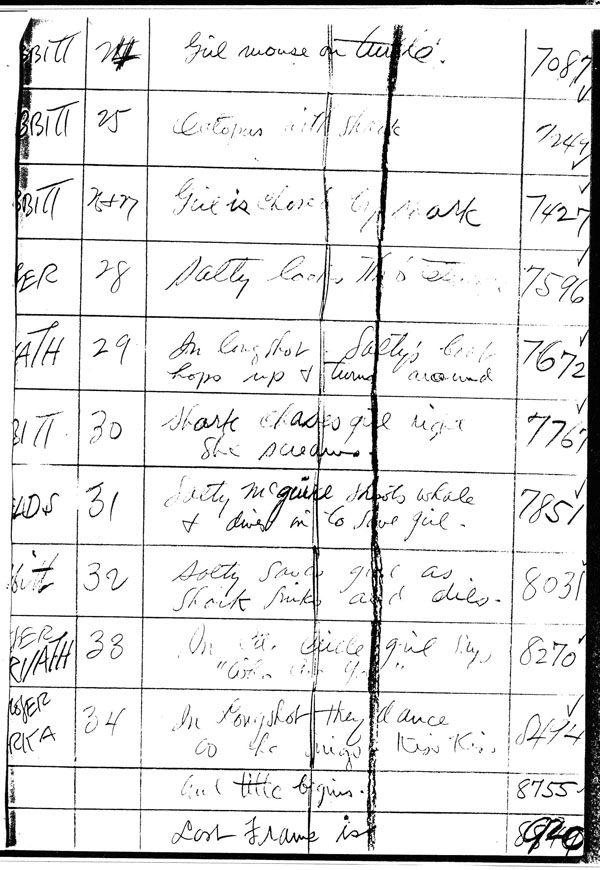
(Thanks to Mark Kausler and Charlie Judkins for their help.)


 DEVON BAXTER is a film restoration artist, video editor, and animation researcher/writer currently residing in Pennsylvania. He also hosts a
DEVON BAXTER is a film restoration artist, video editor, and animation researcher/writer currently residing in Pennsylvania. He also hosts a 





















































































Fantastic job Devon!
Terrific job, Devon. Wish I could read your full outline of Terrytoons. I’m thoroughly enjoying being reacquainted with the cartoons that I find on You Tube.
These charts are an absolute dream come true, and that they exist for such an old short (85 years now!) is nothing short of miraculous. I’ll only comment that Babbitt’s great animation on the death of the shark (“dour” is certainly accurate) made me feel very bad for the shark. A lot of shorts of this period, where revenge is taken on antagonist who has not been built up dramatically as the enemy (he’s just a natural enemy, thus he’s the enemy: even some Disney shorts of this period fall into this category) always put me ill at ease watching them. Heck, even now (at age 54) when I watch a Tom n Jerry short, I’m ALWAYS rooting for Tom!
So Larry Silverman was an assistant animator at that time. This was probably one of his earliest animation jobs. Earlier in 1930 he was listed as a student in the census of that year. I wonder when exactly when he landed at Harman-Ising in California?